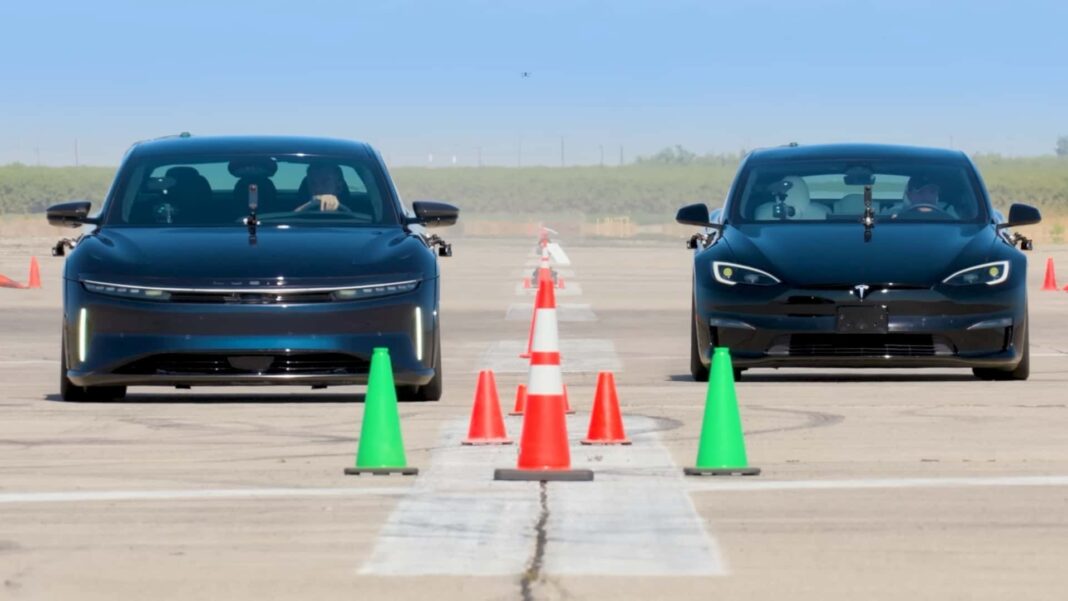- Edmunds compared the Lucid Air Sapphire with the Tesla Model S Plaid with the optional Track Pack.
- Together, the two American EVs produce over 2,200 horsepower.
We live in fascinating times. You could go online right now and place an order for a four-door electric sedan that goes the distance, is comfortable and is seriously fast–among the fastest in the world, in fact.
Two models fit the bill currently, and they’re both made in the United States. There’s the original Tesla Model S Plaid, with its 1,020 horsepower and sub-2-second sprint to 60 miles per hour. Then, there’s the newer, fancier and more expensive Lucid Air Sapphire.
There have been plenty of comparisons between the two EVs, but none quite like the one put together by our friends at Edmunds. As you’ll see in the video embedded below, Edmunds pitted the 2023 Tesla Model S Plaid with the optional $20,000 Track Package against the 2024 Lucid Air Sapphire.
Tesla’s pricey add-on comes with carbon ceramic brakes and forged brake calipers, which enables the 4,810-pound EV to, you know, brake properly. Some fancy wheels are also included, as is some “track-ready brake fluid.” The car’s firmware is also slightly different, to take advantage of the new stuff.
Like the Model S Plaid, the Lucid Air Sapphire is powered by three electric motors. Unlike the Plaid, however, Lucid managed to squeeze out 1,234 horsepower from the setup, lowering the 0-60 mph time to just 1.89 seconds, as opposed to the Model S Plaid’s 1.99 seconds. On paper, at least.
Suffice to say, they’re very fast. Edmunds’ course consists of a quarter-mile drag race, followed by a braking section, a U-turn and then another sprint toward the start/finish line. It’s a very simple layout but it’s designed to test acceleration, braking and handling. Two runs are clocked and at the end of the first run, the drivers switch cars to eliminate any potential advantage or disadvantage.
In the Model S Plaid, the battery was preconditioned for the Drag Strip mode, which took about 15 minutes to complete. The suspension was set to Sport and in the lowest ride height.
In the Lucid Air Sapphire, Track mode was selected, then the Drag Strip option–a little easier than in the Model S, but I’ll give Tesla credit for making the whole operation a little more dramatic, especially when it comes to the Cheetah stance that the Model S Plaid takes right before launch.
Now that the specs are out of the way, I’ll just say this: the race you’re about to see in the video is intense. At the end of the first run, the Lucid Air was clocked at a speed of 164 miles per hour. Let’s not forget that both these cars are four-door family sedans, so experiencing this amount of power and speed seems like cheating physics a little bit.
The second run was a little different, with the Model S set in Track mode instead of Drag Strip mode in the hopes that the car would send more power to the wheels when exiting the corner at the end of the straight. Did it help? Well, not really. For what it’s worth, though, the Model S Plaid, even with the $20,000 Track Pack, is still half the price of the Air Sapphire, which retails for a sweet, sweet $250,500. Meanwhile, Tesla is asking $91,630 for a base Model S Plaid without the Track Pack.
So, is it worth spending a quarter of a million dollars on an admittedly very nice EV? You be the judge.

